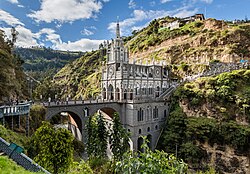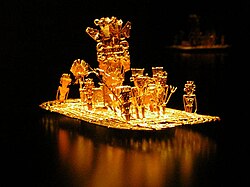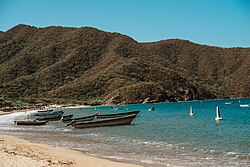
Colombia is a country with a long and complicated history that is situated in northern South America. Originally, a number of indigenous peoples, including the Muisca, Zenu, Tairona, and Wayuu, lived in what is now Colombia. Although the Kingdom of the New Granada was founded in 1538, the first permanent Spanish settlement in Colombian territory was founded in 1510 as part of their quest for the fabled city of El Dorado. [1]
Research your ancestors on MyHeritage
History of ColombiaHistory of Colombia

The history of Colombia encompasses the arrival of indigenous peoples and the formation of agricultural communities, such as the Tairona Chiefdoms, the Quimbaya Civilization, and the Muisca Confederation. After the Spanish conquistadores arrived in 1499, they began a period of colonization and annexation that resulted in the creation of the Viceroyalty of New Granada, which had Bogotá as its capital. After obtaining independence from Spain in 1819, the ensuing "Gran Colombia" Federation was disbanded by 1830 and was separated into Venezuela, Ecuador and the Republic of New Granada, which was formed from what is now Colombia and Panama. Before the Republic of Colombia was formally established in 1886, the newly formed country experimented with federalism as the Granadine Confederation (1858) and the United States of Colombia (1863). Following a period of ongoing political unrest, Panama seceded in 1903. The country has experienced an irregular, low-intensity armed conflict since the 1960s, which worsened in the 1990s before abating after 2005. Rich cultural heritage has been left over from Colombia's past, and the country's diverse geography and climate have aided in the emergence of distinct regional identities.
Geography of ColombiaGeography of Colombia

Colombia's geography is typically divided into five natural regions: the Andes mountain range, which it shares with Ecuador and Venezuela; the Pacific Ocean coastal region; the Caribbean Sea coastal region; the plains known as Llanos, which it shares with Venezuela; and the Amazon Rainforest region, which it shares with Ecuador, Brazil, Peru, and Venezuela. The only nation in South America with coastlines on both the Atlantic and Pacific seas is Colombia.
The regions of ColombiaThe regions of Colombia
Bogotá serves as the capital of the country as well as of the department of Cundinamarca. Colombia is divided into 32 departments and one capital district, which is treated as a department. Departments are further divided into municipalities, which are further divided into comunas in urban areas and corregimientos in rural areas. Each municipality is given a municipal seat.
- Amazonas
- Antioquia
- Arauca
- Atlántico
- Bolívar
- Boyacá
- Caldas
- Capital District
- Caquetá
- Casanare
- Cauca
- Cesar
- Chocó
- Córdoba
- Cundinamarca
- Guainía
- Guaviare
- Huila
- La Guajira
- Magdalena
- Meta
- Nariño
- Norte de Santander
- Putumayo
- Quindío
- Risaralda
- San Andrés y Providencia
- Santander
- Sucre
- Tolima
- Valle del Cauca
- Vaupés
- Vichada
Researching family history in ColombiaResearching family history in Colombia
- Colombia historical records
- Colombian genealogy
- Immigration to Colombia
- Colombian emigration
- Colombian archives
- Vital records in Colombia
- Birth records in Colombia
- Death records in Colombia
- Marriage records in Colombia
- Census records in Colombia
- Civil registrations in Colombia
- Church records in Colombia
- Newspaper records in Colombia
- Voters lists in Colombia
- Military records in Colombia
Research your ancestors on MyHeritage
Colombian surnamesColombian surnames

While most Colombian surnames in Colombia are of Spanish origin[2] due to the Spanish colonization and conversion of indigenous people and African slaves into Christianity, a large number of individuals of these groups retained their ancestral clans names as their surnames, especially in areas where indigenous people are the majority, like in the Guajira on the northeast and Cundinamarca and Boyacá in the center of the country, where Muisca mestizos are the majority. Additionally, Basque surnames are relatively common in the Coffee Axis and Antioquia, as a significant number of Basque immigrants settled there in the seventeenth century.[3]
See alsoSee also
Explore family history in ColombiaExplore family history in Colombia
- Colombia - Collection Catalog at MyHeritage, which contains the following collections:
References
- ↑ Massimo Livi Bacci (2012). El dorado en el pantano (in Spanish). Marcial Pons Historia. ISBN 978-84-92820-65-8
- ↑ Most Common Last Names In Colombia
- ↑ Basque Families of Antioquia. Buber's Basque

